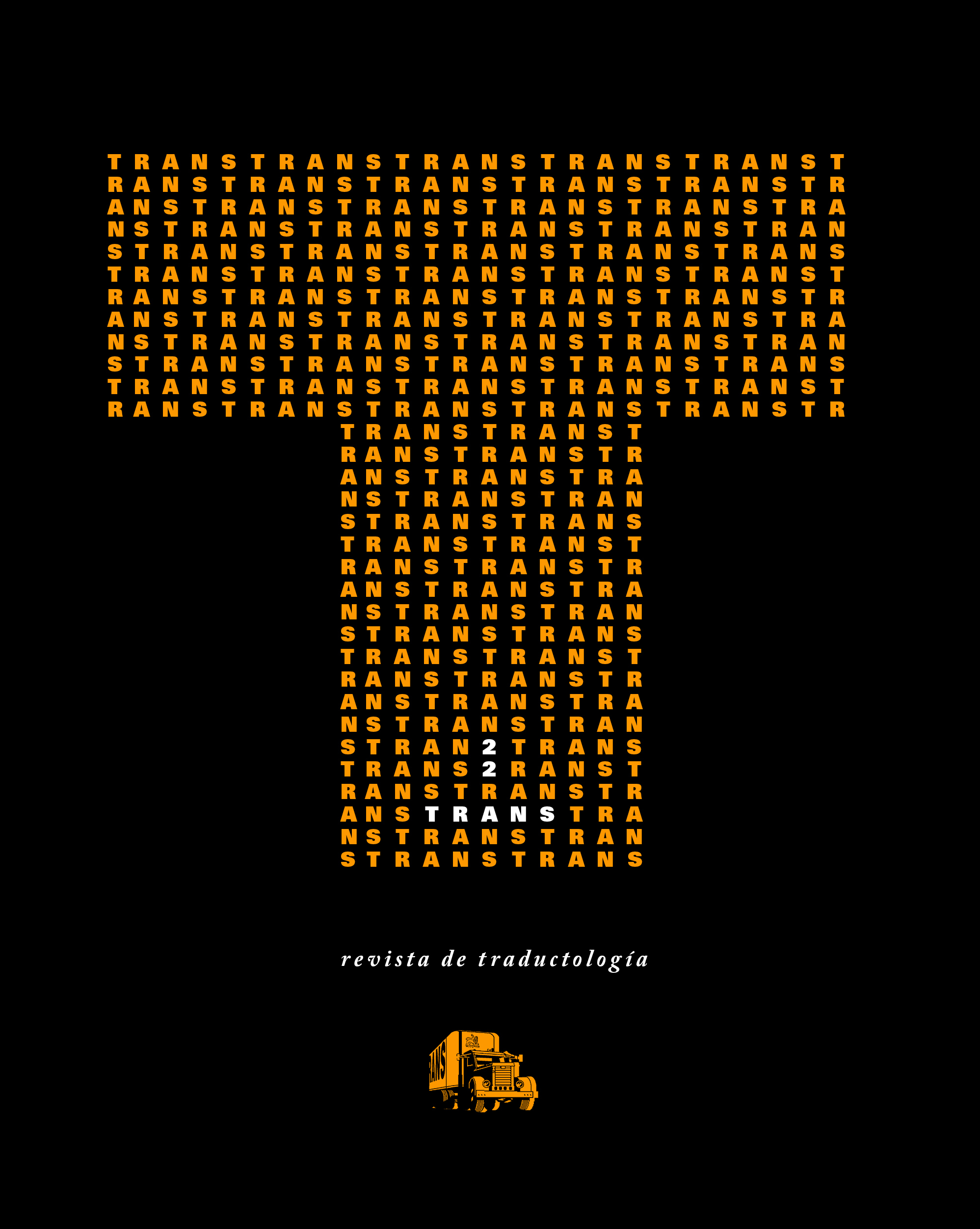El ajuste en videojuegos: el doblaje de Assassin’s Creed Syndicate
DOI:
https://doi.org/10.24310/TRANS.2018.v1i22.2966Palabras clave:
doblaje, traducción audiovisual, localización, videojuegos, ajuste, sincronización.Resumen
El objetivo de este artículo es describir la localización de videojuegos desde la novedosa perspectiva del doblaje: concretamente, se centra en analizar el tipo de sincronización que presenta un videojuego de aventuras, originalmente en inglés y localizado al español peninsular.
En primer lugar, se ofrece una revisión teórica de los tipos de ajuste descritos hasta ahora para cine y televisión, cuyo doblaje será el modelo sobre el que se analizará el nuevo producto audiovisual interactivo que representan los videojuegos.
Descargas
Métricas
Publicación Facts
Perfil de revisores N/D
Información adicional autores
Indexado: {$indexList}
-
Indexado en
- Sociedad Académica/Grupo
- N/D
- Editora:
- Universidad de Málaga
Citas
APPERLEY, Thomas H. (2006): «Genre and game studies: Toward a critical approach to video game genres», Simulation & Gaming, 37/1, 6-23.
ARSENAULT, Dominic (2009): «Video Game Genre, Evolution and Innovation», Eludamos. Journal for Computer Game Culture, 3/2, 149-176.
BERNAL MERINO, Miguel Ángel (2006): «On the Translation of Video Games», The Journal of Specialised Translation, 6, 22-36.
CEREZO MERCHÁN, Beatriz, Frederic CHAUME, Ximo GRANELL, José Luis MARTÍ FERRIOL, Juan José MARTÍNEZ SIERRA, Anna MARZÀ, y Gloria TORRALBA MIRALLES (2016): La traducción para el doblaje. Mapa de convenciones, Castelló de la Plana: Publicacions de la Universitat Jaume I.
CHANDLER, Rafael (2006): «Screen/play: Documenting Voice Assets», Gamasutra, <http://www.gamasutra.com/view/feature/2724/screenplay_documenting_voice_.php> [consulta: 2/I/2017].
CHAUME, Frederic (2012): Audiovisual Translation: Dubbing, Londres y Nueva York: Routledge.
CHAUME, Frederic (2005): «Los estándares de calidad y la recepción de la traducción audiovisual», Puentes, 6, 5-12.
CHAUME, Frederic (2004): Cine y traducción, Madrid: Cátedra.
CHAVES, María José (2000): La traducción cinematográfica: El doblaje, Huelva: Publicaciones de la Universidad de Huelva.
CLEARWATER, David A. (2011): «What Defines Video Game Genre? Thinking about Genre Study after the Great Divide», Loading… The Journal of the Canadian Game Studies Association, 5/8, 29-49.
ENSSLIN, Astrid (2012): The language of Gaming, Nueva York: Palgrave Macmillan.
FRASCA, Gonzalo (2001): «Rethinking agency and immersion: video games as a means of consciousness-raising», SIGGRAPH 2001, <http://siggraph.org/artdesign/gallery/S01/essays.html> [consulta: 2/I/2017].
FRASCA, Gonzalo (2003): «Simulation versus Narrative», en Mark J. P. WOLF y Bernard PERRON (eds.), The Video Game Theory Reader, New York: Routledge, 221-235.
FODOR, István (1976): Film Dubbing: Phonetic, Semiotic, Esthetic and Psychological Aspects, Hamburg: Helmut Buske.
LE DOUR, Corinne Isabelle (2007): «Surviving audio localization», Gamasutra, <http://www.gamasutra.com/view/feature/1713/surviving_audio_localization.php#5> [consulta: 2/0I/2017].
LÓPEZ REDONDO, Isaac (2014): ¿Qué es un videojuego? Claves para entender el mayor fenómeno cultural del siglo XXI, Sevilla: Héroes de Papel.
LOUREIRO PERNAS, María (2007): «Paseo por la localización de un videojuego», Revista Tradumàtica. La localització de videojocs, 5, <http://www.fti.uab.es/tradumatica/revista/num5/articles/03/03art.htm>.
LUYKEN, Georg-Michael, Thomas HERBST, Jo LANGHAM-BROWN, Helen REID y Hermann SPINHOF (1991): Overcoming Linguistic Barriers in Television. Dubbing and Subtitling for the European Audience, Manchester: The European Institute for the
Media.
MANGIRON, Carme y Minako O'HAGAN (2013): Game localization: translating for the global digital entertainment industry, Ámsterdam: John Benjamins.
MANGIRON, Carme y Minako O'HAGAN (2006): «Game localisation: unleashing imagination with ‘restricted’ translation», Jostrans: The Journal of Specialised Translation, 6, 10-21.
MAXWELL-CHANDLER, Heather (2005): The Game Localization Handbook, Massachusetts: Charles River Media.
MÉNDEZ GONZÁLEZ, Ramón (2015): Localización de videojuegos: fundamentos traductológicos innovadores para nuevas prácticas profesionales, Vigo: Servizo de Publicacións Universidade de Vigo.
PÉREZ LATORRE, Oliver (2010): Análisis de la significación del videojuego. Fundamentos teóricos del juego, el mundo narrativo y la enunciación interactiva como perspectivas de estudio del discurso, Tesis Doctoral, Universitat Pompeu Fabra.
PUJOL TUBAU, Miquel (2015): La representació de personatges a través del doblatge en narratives transmèdia. Estudi descriptiu de pel·lícules i videojocs basats en El senyor dels anells, Tesis doctoral, Universitat de Vic - Universitat Central de Catalunya.
RAMOS SERRANO, Marina y Óliver PÉREZ LATORRE (2009): «Hacia el horizonte comunicativo en los estudios del videojuego», Comunicación, 7/1, 1-5.
SCHOLAND, Michael (2002): «Localización de videojuegos», Revista Tradumàtica, 1, <http://www.fti.uab.es/tradumatica/revista/articles/mscholand/art.htm>.
SIOLI, Fulvio, Fabio MINAZZI y Andrea BALLISTA (2007): «Audio Localization For Language Service Providers», Multilingual Localization: Getting Started Guide, octubre/noviembre de 2007, 18-23, <https://multilingual.com/downloads/screenSupp91.pdf> [consulta: 2/0I/2017].
TOURY, Gideon (1995): Descriptive Translation Studies and Beyond, Ámsterdam/Filadelfia: John Benjamins.
WHITMAN-LINSEN, Candace (1992): Through the Dubbing Glass, Frankfurt am Main: Peter Lang.
Publicado
Cómo citar
Número
Sección
Licencia
Todos los contenidos publicados en TRANS. Revista de Traductología están sujetos a la licencia Creative Commons Reconocimento-NoComercia-Compartirigual 4.0 cuyo texto completo puede consultar en <http://creativecommons.org/licenses/by-nc-sa/4.0>
Se pueden copiar, usar, difundir, transmitir y exponer públicamente, siempre que:
- Se cite la autoría y la fuente original de su publicación (revista, editorial y URL de la obra).
- No se usen para fines comerciales.
- Se mencione la existencia y especificaciones de esta licencia de uso.
- Compartir Igual — Si remezcla, transforma o construye sobre el material, debe distribuir sus contribuciones bajo la misma licencia que el original.
Los derechos de autor son de dos clases: morales y patrimoniales. Los derechos morales son prerrogativas perpetuas, irrenunciables, intransferibles, inalienables, inembargables e imprescriptibles. De acuerdo con la legislación de derechos de autor, TRANS. Revista de Traductología reconoce y respeta el derecho moral de los autores/as, así como la titularidad del derecho patrimonial, el cual será cedido a la Universidad de Málaga para su difusión en acceso abierto. Los derechos patrimoniales, se refieren a los beneficios que se obtienen por el uso o divulgación de las obras. TRANS. Revista de Traductología se publica en open access y queda autorizada en exclusiva para realizar u autorizar por cualquier medio el uso, distribución, divulgación, reproducción, adaptación, traducción o transformación de la obra.
Es responsabilidad de los autores/as obtener los permisos necesarios de las imágenes que están sujetas a derechos de autor.
Los autores/as cuyas contribuciones sean aceptadas para su publicación en esta revista conservarán el derecho no exclusivo de utilizar sus
contribuciones con fines académicos, de investigación y educativos, incluyendo el auto-archivo o depósito en repositorios de acceso abierto de cualquier tipo.













21.png)
